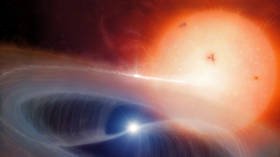Closest to Earth ‘black hole’ turns out to be rare kind of star, after all

A growing body of research posits that the star system HR 6819 does not contain a black hole, contrary to earlier findings. It may instead boast a unique pair of stars.
The object located some 1,120 light-years from Earth has been preliminarily demoted from a bewildering black hole to a binary star system with a rather unusual orbit.
The system consists of a very hot Be spectral type star which spins at approximately 200km per second, shooting out a disc of hydrogen gas which surrounds it.
Previously, it was found to be accompanied by a B3 III star, measuring approximately six solar masses, with a roughly 40-day orbit. The Be star, also measuring in at about six solar masses, seemed to be spinning on the spot, which made no sense as two objects of similar mass should spin about a mutual center of gravity.
Following a serious amount of number crunching, researchers earlier this year concluded that the pair must be orbiting a third, massive object that wasn't visible which would explain why the spinning top star was essentially locked in place – a black hole.
Also on rt.com Closest black hole to Earth discovered just 1,000 light years away, ‘VISIBLE’ to the naked eyeHowever, as is often the case in science, there was a competing theory: that the B3 III star was actually a low mass star that had been worn down by its companion, and that the initial calculations were off.
If this were the case, the almost imperceptible movement of the larger Be star would be visible via wobbles and shifts in the hydrogen gas disc emanating from it.
Sure enough, astronomers Douglas Gies and Luqian Wang of Georgia State University discovered variations in the disc which aligned with the B3 III star's orbit.
“This indicates,” they wrote, “that HR 6819 is a binary system consisting of a massive Be star and a low-mass companion that is the stripped down remnant of a former mass donor star in a mass transfer binary.”
In other words, the Be star took a huge chunk out of its companion and, according to the recalculations, the B3 III star would be between 0.4 and 0.8 solar masses.
By coincidence, a second paper, produced by researchers at KU Leuven in Belgium, conducted an independent analysis of the hydrogen disc emitted by the star and reached almost exactly the same conclusion as Gies and Wang.
In their analysis, they found the pair to have solar masses of 0.4 and 6 respectively.
“This indicates that the primary might be a stripped star rather than a B-type giant,” they wrote. “In the framework of this interpretation, HR 6819 does not contain a BH.”
Also on rt.com Astronomers capture exact moment supermassive black hole DEVOURED entire starBy yet more happenstance, a third paper, currently in preprint, produced by astronomers Kareem El-Badry and Eliot Quataert of UC Berkeley also found 0.47 and 6.7 solar masses for the B3 III and Be stars respectively, providing yet more evidence of an unusual binary star pair instead of a black hole in our cosmic backyard.
Astronomers have been puzzled by the HR 6819 system for the past three decades. If all of the new findings are confirmed by future observations, it may present a more unique opportunity for scientists as it might indicate a star at a rare point in its evolution which is seldom witnessed first-hand.
Scientists may be able to study a companion star which has recently completed mass transfer but has yet to reach the ‘white dwarf’ cooling stage of its evolution, contributing to the further understanding of star formation in the wider universe.
Like this story? Share it with a friend!














